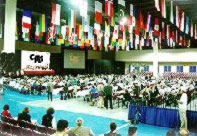For use of the media only;
not an official document.
PRESS RELEASE
New CITES trade rules proposed for wild plants and animals
Toothfish, mahogany, whales, elephants, vicuña, and turtles at issue
 Geneva, 14 June 2002 – The Secretariat of the Convention on International Trade in Endangered Species of Wild Fauna and Flora (CITES) has announced today the receipt from member governments of 54 proposals to amend the lists of species subject to trade controls or prohibitions.
Geneva, 14 June 2002 – The Secretariat of the Convention on International Trade in Endangered Species of Wild Fauna and Flora (CITES) has announced today the receipt from member governments of 54 proposals to amend the lists of species subject to trade controls or prohibitions.
“Some of the important issues raised by this year’s proposals include what role CITES should play regarding commercially valuable fish and timber species and the kinds of incentives that local communities will need to continue protecting the wildlife that surrounds them,” said Willem Wijnstekers, the Convention’s Secretary-General.
“CITES’ efforts to reduce threats to individual wild species are vital to the broader goal of making environmental conservation and poverty reduction mutually supportive,” said Klaus Töpfer, Executive Director of the United Nations Environment Programme, which administers the CITES Secretariat.
The CITES lists, or Appendices, are revised every two-and-a-half years. Appendix I prohibits all commercial trade in some 900 species that are threatened with extinction. Appendix II regulates trade in 4,000 animal and 22,000-plus plant species through a system of permits. The deadline for submitting the new proposals was 6 June, and the Secretariat will issue its comments on these proposals in July. The Convention’s 158 Parties will then meet in Santiago, Chile from 3 to 15 November to decide whether to accept, reject or modify the proposals.
Of particular interest will be the debate over the proposed listing in Appendix II of two species of toothfish, or Chilean sea bass. The toothfish proposals raise the issue of CITES’s role regarding valuable and heavily traded fish stocks and its relationship to regional fisheries agreements, the Food and Agriculture Organization and other international regimes. Other species proposed for inclusion on Appendix II include bigleaf mahogany, seahorses and 26 species of freshwater turtles.
A high-profile item for the Santiago conference will be the African elephant. After an eight-year ban on ivory sales, three African countries – Botswana, Namibia and Zimbabwe – were allowed to make one-time sales from their existing legal raw ivory stocks in 1997. They made proposals for annual quotas in 2000 but then withdrew them. The debate over elephants has focused on the benefits that income from ivory sales may bring to local communities and conservation programmes versus the concern that such sales may inspire increased poaching.
This year, the three countries plus South Africa are proposing a one-off sale of existing ivory stocks followed later by annual quotas. The proposals are for a first sale of 20,000 kg and an annual quota of 4,000 kg for Botswana, 10,000 kg and 2,000 kg respectively for Namibia, 30,000 and 2,000 for South Africa and 10,000 and 5,000 for Zimbabwe. Zambia too is now proposing a one-off sale of 17,000 kg. India and Kenya, on the other hand, are proposing that all African elephant populations be returned to Appendix I.
A number of other proposals involve transferring species from Appendix I to Appendix II in order to permit trade. Cuba would like to sell 7,800 kg of hawksbill turtle shells from existing legal stockpiles. Japan is seeking the transfer of most northern hemisphere populations of minke whale and a Pacific population of Bryde’s whale; its proposals stress the use of national legislation and DNA identification of individual whales to monitor catches and trade. Argentina, Bolivia and Chile want to expand their ability to sell the fine silky wool sheared from live vicuña to include a number of additional vicuña populations.
Note to journalists: For further information please contact Michael Williams at +41-22-917-8242 /8196 /8244 or michael.williams@unep.ch. The proposals are being posted at www.cites.org.